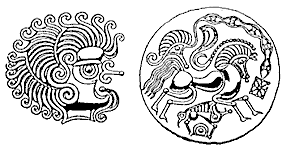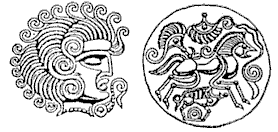
| Home | General Index | Index of mythological subjects |

| Home | General Index | Index of mythological subjects |
The 'banners' seen in front of the pony in many of the Series Y Coriosolite coins are also to be found on the coins of other tribes, both Armorican and from further afield. The banner has been usually described as a 'vexillum'. This Latin term refers to a military standard, and while sounding impressive, there is no evidence to support this interpretation. There is, however, considerable evidence to support a religious interpretation for these symbols. My ordering of the Coriosolite coins has provided the strongest evidence for this interpretation.

The coin above (Series Y, Group M) depicts a quadrilateral banner in front of the pony. This is connected by means of a 'lash' (in this case enclosing X's) to the driver's forehead. The style of this banner is the commonest in the Coriosolite series.

Variations on a theme - 1: The usual banner design, 2: opposed diamonds, 3: opposed chevrons, 4: opposed X's. The die engraver used the commonalty of the designs to identify the religious content.
The coin illustrated depicts No. 1. in the above diagram. This symbol is very ancient. I have mentioned elsewhere of its occurrence in Irish Megalithic art, and the omphalos connection in Brittany discussed by V. Kruta.
There is a sub group within group H consisting of dies identified on the obverse by a 'C' shaped mouth and multi-lined mouth ornament, and on the reverse by a beaded martingale in front of the pony. The intentions of the die engraver were somewhat thwarted by the moneyer who mixed up the dies, so that the reverse dies in this sequence started two coins before the obverse dies. Each of one the dies so marked contains a banner of a different design. Each design exhibits quadrilateral symmetry, although we might be expected to view this more as bilateral. This common element, coupled with the other 'markers' to isolate these dies identifies the creative action of the die engraver in what I call 'variations on a theme'.
The commonalty of the designs points to the interpretation. This element is a 'crossover' between one state and another. It is often used in magic by the concept of 'as above, so below' and is the basis of primitive imitative magic. The concept is not extinct, but lives in theoretical physics as a typical 'S' matrix theory element, where in designs like No. 1 it demonstrates a collision point (the centre) between two or more particles, and the resulting emanation from that point of two or more new particles.
The meaning of the spiral is very similar to that of the quadrilateral banners, and on some coins they are paired, while they are very commonly substituted. One of the obverse dies (see below) had a mouth ornament that consisted of two lines connecting a curl and leaf motif to a pellet-in-circle sun symbol. This was probably the obverse die that signalled the end of the sequence. The fact that obverse and reverse both depict a curl and leaf could indicate that this die pair are intended to be together and that the spiral on the reverse indicates the same as the quadrilateral banners. This is speculative and the evidence is not strong enough for more certainty.
